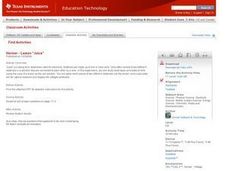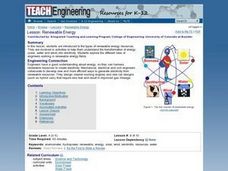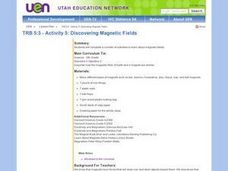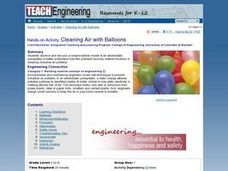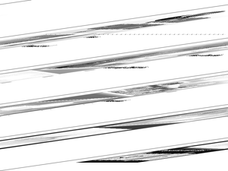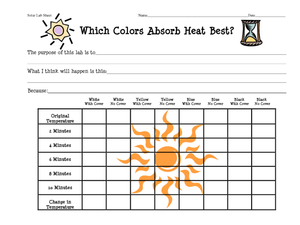Curated OER
Acids and Bases: Their Reactions, Conductivity, Base Indicators and Neutralization Reaction
Students conduct experiments and collect data to determine physical and chemical characteristics of acids and bases.
Curated OER
Gel Electrophoresis
Students conduct a variety of experiments to explore gel electrophoresis. In this biology instructional activity, explain how this process separate DNA and RNA. They discuss the practical applications of this method.
Curated OER
Science Lesson: Home-made Generator
Students are able to design and conduct an experiment related to electrical generation. They are able to list the factors that affect the amount of current that can be generated by a simple generator, such as the number of turns of...
Curated OER
Science: Wind Power
Students build models of wind turbines and experiment with different designs that will improve efficiency. Students will understand the use of wind power as a renewable resource.
Curated OER
Insulators and Conductors
Fourth graders experiment to discover which items are conductors and which items are insulators. In this insulators and conductors instructional activity, 4th graders experiment and create a T-Chart. Students are assessed on the...
Curated OER
Lemon "Juice"
Middle schoolers explore the concept of electricity in this lesson as they measure the electricity that a lemon gives off. Learners use volt meters to measure the amount of electricity coming from the lemon. Your class will also measure...
Curated OER
TE Lesson: Renewable Energy
Students examine renewable energy sources such as solar, water, and wind. They experiment to determine how renewable energy is transformed into electricity. They investigate the role of engineers who work in the field of renewable energy.
Curated OER
Solar Energy Connection
Students conduct solar experiments. They calculate the solar gain and operate a solar cell devise used to generate electricity. Students compare and contrast solar energy gain with students in India. They analyze the difference...
Curated OER
Will the Lights Go Out?
Students diagram nuclear power plant, describe process for generating electrical power, discuss nuclear disasters in the 20th century, and draw conclusion about value of nuclear power for the future.
Curated OER
Science: Mirrored Movements
This lesson provides students with a lab experience during which students construct a basic electric circuit and use it to explore dexterity skills. A chance to construct and operate a tool that extends a person's grasping ability and to...
Curated OER
Chemical Bonding
Students classify compounds as ionic or covalent. In this chemical bonding lesson plan, students experiment with 6 chemical compounds. They test physical properties such as the melting point, the solubility and the electrical...
Curated OER
Matter, Matter
Middle schoolers define vocabulary related to the parts of the atom. In this matter lesson, students navigate the web to find the structure and the forces that affect atoms. Middle schoolers complete an experiment with positive and...
Curated OER
The Affect of Water Temperature on Living Organisms
Students examine the environmental impact of global warming. In this environmental science lesson, students design and conduct an experiment about the effect of temperature on paramecia. They write a lab report about their experiment.
Curated OER
The Wonderful World of Waves (Wave Basics)
High schoolers define amplitude, wavelength, frequency, and period, calculate period given frequency, and calculate frequency given period, define crest and trough and locate both on diagram of wave, differentiate between latitudinal and...
Curated OER
Discovering Magnetic Fields
Fifth graders examine the different types of magnets (bar, horseshoe, disc, ball, etc.) and experiment with the magnets and iron filings to discover the magnetic fields of each type of magnet.
Curated OER
Cleaning Air with Balloons
Young scholars examine how a pollutant recovery method functions in cleaning industrial air pollution. They listen to a teacher-led discussion, conduct an experiment with balloons, static electricity, and pepper, and observe and record...
Curated OER
Reduced Fare
Students discover the relationship between tectonic plate boundaries and the communities of life that thrive at such boundaries. In this biology lesson, students find that methane from oxidized carbon in sediments provides nutrients for...
Curated OER
Creating a Simple Telegraph Machine
Students experiment and discuss circuits and how they work. In this science lesson, students construct a telegraph machine using cardboard, wires, battery, electric tape and masking tape. They investigate what happens as the circuits...
Curated OER
Capturing Wind Energy
Students investigate technology and make a correlation between technology and the weather. In this science lesson, students experiment with the weather and climate using technology to help them understand forces and motion. They identify...
Curated OER
Stormy Weather
Students conduct experiments. In this weather lesson, students review what they know about weather elements such as cloud formation and storms. Students conduct demonstrations and learn how lightning strikes.
Curated OER
Exploring Meteorite Mysteries: Building Blocks of Planets
Students simulate the formation of chondrites and asteroids. In this astronomy lesson, students demonstrate accretion using balloons and static electricity. They compare and contrast their models to the actual process of chondrites and...
Curated OER
Reuse, Reduce, Recycle Paper
Young scholars experiment with recycling paper. In this paper recycling lesson plan, students conduct an experiment in which they dissolve newspaper in water and cornstarch to make new pieces of paper. They add color or flowers to the...
Curated OER
Cooking with the Sun!
Students access prior knowledge of solar energy and understand that solar energy produces heat. In this solar cooker lesson, students complete grade appropriate experiments using the heat of the sun. Students complete a worksheet on...
Curated OER
Elaine Humphrey, Gwynne Thompson
Second graders become familiar with the parts of the microscope and how it works. In this microscope lesson, 2nd graders experiment with different light and settings. Students answer questions based on their experiment.







